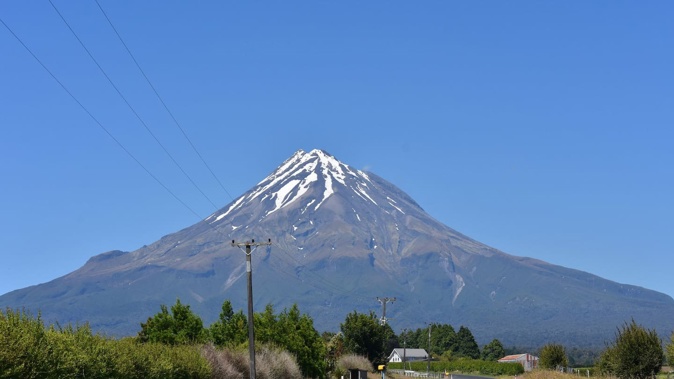
A Mt Taranaki eruption could bring the region to a standstill, knock out regional infrastructure and cause up to $16 billion worth of damage, a new study has found.
Researchers across New Zealand undertook a five-year study weaving together volcanic science, dynamic risk modelling, economic analysis and mātauranga ā iwi to project what would happen if the volcano erupted.
University of Auckland Professor Shane Cronin said the programme began because researchers knew there was a 30-50% chance that Taranaki could erupt in the next 50 years.
“Our job was to listen to the mounga, study its past behaviour, and start to understand what signs it might give before erupting again.”

University of Auckland Professor Shane Cronin.
What have scientists learned?
Analysis of volcanic layers in local caves narrowed down the timeline of previous eruptions from around 70-90 years to around seven to nine years.
The most recent eruption is now confirmed to have occurred in 1790.
Cronin said this level of precision gave scientists a much clearer window into Taranaki’s eruption history.
“We’ve now also able for the first time able to see the duration of eruptions. For example, some of the smaller eruptions have lasted for around 2-3 years,” he said.
Researchers developed nine eruption scenarios.
They range in size and duration to show what small, medium, or large eruptions may look like over months.
“The scenarios were a game-changer,” University of Canterbury Professor Tom Wilson said.
“Suddenly, people could understand how they may be impacted and were starting to think about the things they could do to prepare.”
The research revealed how a disruption to the electricity system could cascade through the oil and gas industries, transport networks, and water systems, causing widespread impacts across the region and nation.
“The risk modelling suggests a Taranaki eruption is a potential regional disaster, it’s a national energy security challenge, and a potential future economic crisis,” Wilson said.
“The ripple effects of an eruption go far beyond ash and lahars.
“Volcanic ash can short-circuit power lines, block roads, contaminate water sources, and clog water treatment plants, causing critical infrastructure systems to fail at the exact time they’re needed most.
“Lahars could also destroy bridges and cut off lifeline services, disrupting transport and access to basic needs like food and water, as well as limiting access to some communities.”

University of Canterbury Professor Tom Wilson.
The economic impact of an eruption
Economic modelling predicts losses from a future eruption of Taranaki mounga could be between $12b and $16b, depending on the type, scale, and duration of the event.
The research programme’s co-lead, Garry McDonald of Market Economics, said a volcanic eruption could bring Taranaki’s economy to a standstill.
“Taranaki supplies 100% of domestic gas and 20% of New Zealand’s primary energy,” he said.
“If gas production halts, it may not be recoverable. Water entering wells could make them unusable or uneconomic to restart, triggering a national energy crisis.”
However, targeted investments in alternative forms of energy could significantly reduce losses, McDonald said.
“An islanded electricity supply for New Plymouth could reduce outage duration by one month and save over $500 million”, he said.
“A backup borehole water supply for South Taranaki could avoid outages for 8,000 plus homes and save more than $600 million.”
McDonald said high-value interventions such as alternative power and water supplies could save more than $1.1 billion and boost regional GDP by 17% over two years.
“Spending now to strengthen critical infrastructure could save billions later.
“It’s not just a way to ensure people have water and power, it’s also smart economics.”

Researchers developed nine eruption scenarios from small, medium to large for Mt Taranaki. Photo / Clive Wilkinson
Weaving mātauranga Māori and risk science
The programme worked in partnership with Uri to weave together mātauranga Māori and Western science.
Bilingual resources, interactive StoryMaps, and wānanga created spaces for kōrero about the mounga’s past and future.
“You can’t understand volcanic risk in Taranaki without understanding the whakapapa of the mountain, whenua and awa, the kōrero tuku iho and mātauranga held by whānau, hapū and iwi who hold ancestral connections to the mounga and have done so for generations,” said Acushla Dee Sciascia of Mapuna Consultants.
This research provided a platform for Māori researchers to contribute their voices, leading to richer outputs including monographs, visual exhibitions, and new ways of telling the mounga’s story.
“Taranaki mounga provides us with so many learnings from its past and how our tūpuna navigated previous volcanic events, and it’s up to us now to prepare our whānau for the future,” Sciascia said.
“This programme has laid a foundation. But the real mahi is in how we carry this forward, and how we embed mātauranga Māori into everyday planning, science, and response.”
Cronin said researchers, iwi, and emergency managers came together to ask: “How do we prepare for a future eruption?”.
Wilson said researchers know far more now than they did.
“But unless our systems evolve to act on that knowledge, the risk remains,” he said.
“Early investment will save billions, protect lives and livelihoods, and strengthen national resilience. The science supports the investment.”
Take your Radio, Podcasts and Music with you









